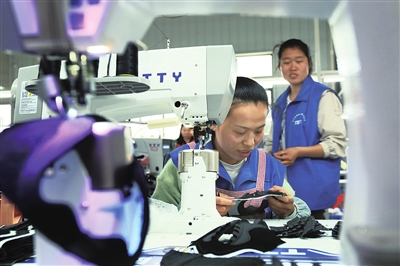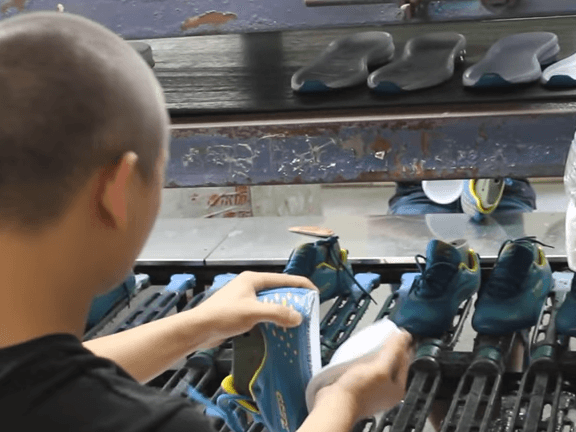News
How Does a Factory Make Shoes?
When you walk into a modern shoe factory anywhere in the world, you will see the same footwear manufacturing processes. In China, America, Brazil, and Italy the art of shoemaking is the same. You will see that the giant 20,000 shoe city in China and the high-end London handmade shoe shop actually have a lot in common.
All the major shoe companies use the same basic techniques for making modern athletic, fashion, hiking, hunting, or casual shoes. For example, Nike, Adidas, and Reebok all use the same techniques and, in many cases, the same factories.
How many processes does it take to make a shoe?
The answer is hundreds if not thousands! Here are the basic operations:
1. Design the shoe.
2. Develop the shoe. (Make the design into a functional shoe.)
3. Order the shoe materials.
4. Prepare the shoe materials by cutting, printing, and laminating.
5. Sew the materials together.
6. Last the uppers.
7. Assemble the outsoles.
8. Pack the shoes.
Eight easy shoemaking steps! Steps one and two can take over a year. Steps six through eight can take 10 minutes. Let’s learn more.
How to make shoes
The first thing you need to make a shoe is called the LAST. The shoe last is a wood, plastic, or metal form that gives the shoe its shape. You would think the last would follow the shape of the human foot…
and it does…sort of. Each shoe style requires its own last to set its shape and size. In addition, every shoe size requires a left last and a right last. So, to make a standard 14 size size-run, you will need at least 28 lasts. If you want to use a modern, high-speed assembly line and make 2,000 pairs of shoes a day, you will need about 700 pairs of lasts!
The shell pattern
Once you select the last for the specific style of shoe you are making, you will need to make a SHELL PATTERN to follow this last. The shell pattern is simply the flat shape that can be stretched over the last into a 3-dimensional shape. This is the shoemaker or patternmaker’s art. The technical term is “SPRINGING the pattern.” With the shell pattern complete, the designer and pattern master can make the design for the shoe parts.

Once the shoe pattern is designed, the factory will cut the pattern parts for the shoe upper. This is the job of the shoe factory’s cutting department. The factory will use giant cookie cutters, computer-controlled knives, laser, water, or hand cutting to make all the parts. Again, the cutting department must cut each part of the shoe, inside and out, padding, and reinforcements. If a shoe has 20 parts, the factory will need 20 cutting dies x 14 sizes. It is not unusual to have thousands and thousands of cutting dies.
The footwear stitching department

Once all the parts are cut and organized into kits, the stitchers can go to work. This part of the factory is called the stitching department or stitching line. A single stitching line may have 50 to 100 workers depending on the complexity of the shoe. Generally, two stitching lines can support one assembly line. First, the stitchers put together the shoe’s outer shell, inside lining, and tongue parts. The stitchers will also add reinforcements, hardware, lace loops, collar foam, and heel counters. Next, the stitching department will handle the heel and toe forming operations. The final stitching operation is to attach the pattern part that closes the bottom of the finished upper. This is called the Strobel sock. The Strobel stitch is the caterpillar-like stitching that runs along the bottom edge when you look inside a sports shoe.
With the stitching complete, it is time for FINAL ASSEMBLY. This is done on the ASSEMBLY LINE. Not to be confused with the stitching or stock fitting lines. Final assembly is when the shoe upper is joined with the outsole

Hand lasting
This first step is called lasting. At this point, this shoe is loose and floppy and is not shaped like a shoe or a human foot. Shoe lasting is the process when you pull this upper over a form (the last) that allows it to stretch and take the shape of a real shoe. The last can be made of wood, plastic, or metal, depending on the kind of shoe you are making and the cementing process. In addition, the upper may be steam heated to aid the lasting process. There are many different ways to last a shoe. (See the articles: Shoe Lasting and Shoe Lasts to learn more.)
Add the shoe outsole

Once you have the upper lasted, it’s time to apply the bottom. This can be done in several ways: contact cement, vulcanizing, nailing, or sewing operations. (See the article: Cold Cement vs. Vulcanized Shoe Construction) In the case of cementing, the lasted upper (with the last still inside) and the outsole units are primed and cemented together. A pressing operation ensures a good bond. Once the last is removed, the shoe is laced up, cleaned, and checked by quality control operators before packing.
RELATED NEWS
- All You Need To Know About Dress Shoes 2023-09-28
- How Women’s Wholesale Shoes Are Made 2023-09-28
CATEGORIES
LATEST NEWS

CONTACT US
Contact: Wendy Ho
Phone: +86-18665080175
E-mail: wendy@gujushoes.com
Whatsapp:+86-18665080175
Add: #711, Building G, Xiamao 16th Community Industrial Zone, Baiyun Lake Street, Baiyun District, Guangzhou, Guangdong, 510000, CN
